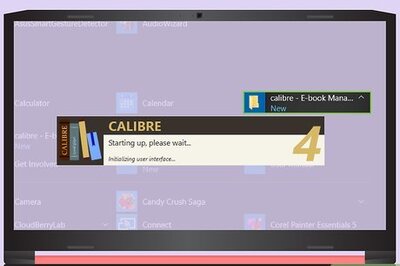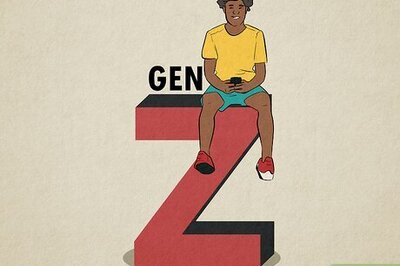
views
A recent article that I wrote on Jawaharlal Nehru’s ‘Panch Bhool’ or ‘Five Blunders’ on Kashmir has invited varied reactions. Among other things, I wrote that Maharaja Hari Singh’s government wanted to accede to India even before August 15, 1947, but it was Nehru who refused. This assertion was based on a version of events narrated by Nehru and no one else.
It is in this context that the response to my article by Dr Karan Singh is deeply disappointing. He completely skipped the other four blunders of Nehru – suo motu insisting that the accession was provisional; moving the UN under the wrong Article after Pakistan’s invasion, thereby making it a party to the dispute instead of an aggressor; letting the myth of a UN-mandated plebiscite perpetuate; and creation of the divisive Article 370.
Obviously, there were no answers or even a modicum of plausible defence. But on the first and primary blunder – of Nehru delaying the accession itself – Dr Karan Singh has presented a sanitised history, resorted to poor wordplay, and, that too, in a roundabout way to somehow extricate Nehru. However, this was not enough for the Congress.
A lifetime of devotion to Nehru despite voluminous evidence of his blunders, could still not save Dr Karan Singh from the acerbic reminder of his place by Jairam Ramesh of the Congress.
That the Congress and its ruling dynasty puts Nehru (and the later members of the dynasty) first and India later, is a well-established fact. But it is time for students of history to find the courage, in light of facts, to set history right, clear the name of those unfairly besmirched by family historians to make Nehru look good.
To the specific points raised, here is a brief set of facts.
On the timing of accession
The clincher should be Nehru’s speech dated July 24, 1952, in Lok Sabha where he mentioned that the question of accession “came up before us informally round about July or the middle of July” and further stated that “we had contacts with the popular organisation there, the National Conference, and its leaders, and we had contacts with the Maharaja’s Government also“. Nehru then, in the same speech, went on to assert his own stance – “the advice we gave to both was that Kashmir is a special case and it would not be right or proper to try to rush things there”.
Since circuitous denial of this history has been resorted to, let us then look at further primary as well as corroborative evidence.
First, on October 21, 1947, in a letter to MC Mahajan, Prime Minister of Kashmir, Nehru wrote, “It will probably be undesirable to make any declaration of adhesion to the Indian Union at this stage.” What do these words convey? Who was asking for accession and who was delaying it? Pakistan had already invaded Kashmir on October 20, 1947. On October 21, a day later, Nehru was still advising the Kashmir government not to accede to India till his personal wishes and agenda were fulfilled (which he explicitly enunciated in the same letter). Will this evidence be denied as well?
Second, in a speech delivered on November 25, 1947, in Parliament, when the issue was still evolving internationally, Nehru stated – “We did not want a mere accession from the top but an association in accordance with the will of her people. Indeed, we did not encourage any rapid decision.”
As clear as daylight, not once but on multiple occasions, Nehru himself stated as to who was putting conditions on accession and thereby delayed it till the personal agenda was fulfilled.
But this is not the only evidence, although more than sufficient as it is, available that throws a light on the chain of events.
Third, Acharya Kripalani, president of the Indian National Congress, visited Kashmir in May 1947. A report published in The Tribune on May 20, 1947, recorded this about Kripalani’s views: “Hari Singh was keen to accede to India and that it was not correct on the part of the National Conference to raise the demand of ‘Quit Kashmir’ against Hari Singh. ‘He is not an outsider’…He appealed to the National Conference in particular to give up the call of ‘Quit Kashmir’.”
The ‘Quit Kashmir’ movement was launched by Sheikh Abdullah in 1946. He was supported in this agitation by Nehru. Hari Singh, a Dogra king, was not an outsider to Kashmir and had as many rights in the Kashmir Valley as anyone else. Every other Congress leader understood the absurdity of replicating the ‘Quit India’ call against colonial British with a ‘Quit Kashmir’ call against a Kashmiri Hindu ruler. Yet, Nehru plunged headlong in support of Abdullah and even landed up in Kashmir to support him. This started a chain of events that had decades-long tragic consequences.
As early as 1931, during the Round Table Conference in London, Hari Singh had asserted in the House of Lords as Vice-Chancellor of Chamber of Prince’s: “I am an Indian first, and then a Maharaja.” The same Hari Singh was, thus, obviously pleading to join India in 1947 on multiple occasions but was thwarted on each occasion till Nehru’s agenda was fulfilled.
Fourth, Nehru’s note to Lord Mountbatten before his visit to Kashmir in June 1947 is unequivocal on what Hari Singh actually wanted. Nehru wrote in para 28 of that note – “The normal and obvious course appears to be for Kashmir to join the Constituent Assembly of India. This will satisfy both the popular demand and the Maharaja’s wishes.” So, Nehru was absolutely aware in June 1947 of what Hari Singh actually wanted. The only stumbling block was Nehru’s own agenda.
Fifth, with the July 1947 attempt of accession rebuffed by Nehru, an attempt was made by Hari Singh in September 1947 as well, a full month before Pakistan’s invasion. Mahajan, Prime Minister of Kashmir at the time of accession, recounts his meeting with Nehru in September 1947. Writing in his autobiography, Mahajan states: “I also met Pandit Jawaharlal Nehru, the Prime Minister of India… The Maharaja was willing to accede to India and also to introduce necessary reforms in the administration of the state. He, however, wanted the question of administrative reforms to be taken up later on. Panditji wanted an immediate change in the internal administration of the state.”
Thus, we see that statements by Nehru, not once but on multiple occasions, and letters written by Nehru, along with corroborative evidence, unambiguously establish the fact that the only cause that delayed Kashmir’s accession to India was Nehru’s own personal obsession.
What actually happened
Abdullah had given a call of ‘Quit Kashmir’ in May 1946. Hari Singh had him arrested on May 20, 1946. Nehru rushed in to support Abdullah, Hari Singh detained him at the border. An aide of Nehru recorded in a note Nehru’s reaction on being detained – “He violently trampled his foot on the floor and told them that one day the Maharaja of Kashmir would have to repent and apologise to him for the discourtesy shown to the president-elect of the Indian National Congress.”
Nehru, so embittered, ruthlessly chose his time to avenge the discourtesy.
The sequence of events of 1947
Kripalani in May 1947 advised to drop the insistence on ‘Quit Kashmir’ and facilitate accession, which Hari Singh wanted, but to no avail.
Nehru was aware even in June 1947 that all that Hari Singh wanted was to join the Indian dominion. Nehru stated as much in his note to Mountbatten.
Hari Singh’s government actually approached Indian leadership in July 1947 (per Nehru’s own statement) to join India but Nehru declined. For no other princely ruler was the criteria of popular support invented to determine accession. It was neither a legal requirement nor necessitated by statecraft. Yet, only for Kashmir, Nehru conveniently invented this ruse to thwart accession until his demand pertaining to Abdullah was met.
Undeterred, Hari Singh tried again, this time through a new person. Mahajan, now PM-designate of Kashmir, personally approached Nehru to join India in September 1947. Hari Singh, by this time, had agreed to most demands made by Nehru, accepted to change the administration of Kashmir but only requested that it be done after accession. Nehru still remained adamant and wanted the administration change – installation of Abdullah – first and accession later.
With Nehru adamant to have his way, Hari Singh made a further concession and released Abdullah from prison on September 29, 1947. Armed with this concession, Hari Singh’s government again approached Nehru to accede to India on October 20, 1947. Nehru refused again through a letter on October 21, and this time put in writing what he actually wanted – installation of Abdullah to head a provisional government. Nehru was very clear in his sequencing. Abdullah first, accession later.
In case anyone doubts this incontrovertible sequence of events, then there is one more proof – again by Nehru himself, and in writing. In a letter to Sardar Vallabhbhai Patel on September 27, 1947, Nehru wrote: “There is no other course open to the Maharaja but this: to release Sheikh Abdullah and the National Conference leaders, to make a friendly approach to them, seek their cooperation and make them feel that this is really meant and then to declare adhesion to the Indian Union.”
Nehru could have forced Hari Singh to accept anything he wanted after the accession. This is exactly how it panned in every other princely state. Logic, national interest and common sense dictated that Nehru first get the country united, forever close the door to Pakistan by making Kashmir irrevocably accede to India and then later, if he was so enamoured by Abdullah, make him head the government. This would have been the ‘India First’ approach. But for some inexplicable reason, Nehru put Abdullah first and India second.
Ultimately, history panned out the way it did. Pakistan got time to invade Kashmir and become a party and occupy large portions of it. Subsequent tragic events in Kashmir have all been a corollary of this original sin.
As for Hari Singh – well, he indeed had to ‘Quit Kashmir’ and only his ashes returned later.
On prior intelligence regarding Pakistani invasion
Dr Karan Singh also mentioned in his article that there was lack of prior intelligence regarding the Pakistani invasion. Perhaps, he meant Hari Singh had no intelligence inputs. But the same is not true about Nehru. In his Parliament speech dated November 25, 1947, Nehru accepted that he was aware in advance. “In September, news reached us that tribesmen of the northwest frontier province were being collected and sent to the Kashmir border.” In the same speech, Nehru further states, “About this time, the state authorities asked us to supply them with arms and munition. We agreed to do so in the normal course. But in fact, no supply was made till events took a more serious turn.”
Before this speech, on November 2, 1947, Nehru had addressed the nation on Kashmir. In this long speech, Nehru stated, “We were asked by Kashmir state to provide them with arms. We took no urgent steps about it and although sanction was given by our state and defence ministries, actually no arms were sent.”
This clarifies further the callous role Nehru was playing with security of the region – using it as a tool to get his demands fulfilled. The Kashmir region, in particular, and India, in general, are still paying the price for this gamesmanship by Nehru.
Other interventions
Many additional interventions have also been made on the accession chronology that essentially regurgitate the old establishment theory of a dithering Hari Singh and a keen Nehru. New facts and documents, some of which have come into the public domain only recently, when studied holistically, present a new perspective on the accession chronology. Nehru’s writings and speeches, as the events unfolded, are sufficient proof of what actually happened.
Finally, the Congress has reacted in a predictable manner to an article that relied on Nehru’s own speech as primary evidence. Such was the desire of the Congress to falsify history that they fielded Jairam Ramesh, who crudely reminded Dr Karan Singh of his actual standing in the party that he has served his entire life. I am sure that the response of the Congress to this article as well, which is again entirely based on Nehru’s own writings and speeches – and other primary corroborative evidence – would be to again crudely indulge in assertion of fact-free history. This has been the method of the Congress in the last seven decades – of shutting down any scholarly debate that challenges the glorification of the dynasty, and I am sure it will be the same again. Research will not be answered by research (since there can be no answer) but it will be answered by abuse and name-calling.
However, it is time for the rest of us as a nation to rebuff attempts to falsify history and stand true to the people of the region of Jammu, Kashmir and Ladakh. The people of this region, along with the rest of India, deserve to know the truth of what actually happened during those tumultuous months and years.
The sources used for quoting various people in the above article are:
- Prime Minister Jawaharlal Nehru’s address in Lok Sabha. July 24, 1952
- Jawaharlal Nehru’s Speeches. Vol. 1. September 1946-May 1949
- Selected Works of Jawaharlal Nehru. Series 2, Vol. 3. June 1947-August 1947
- Selected Works of Jawaharlal Nehru. Series 2, Vol. 4. August 1947-December 1947
- MC Mahajan Book. Looking Back: The Autobiography of Mehr Chand Mahajan.
- JN (SG), MSS, NMML, 1946 (The note by aide of Nehru recording his behavior after his detention by Hari Singh)
- The Tribune newspaper published on May 20, 1947
Read all the Latest Opinions here


















Comments
0 comment